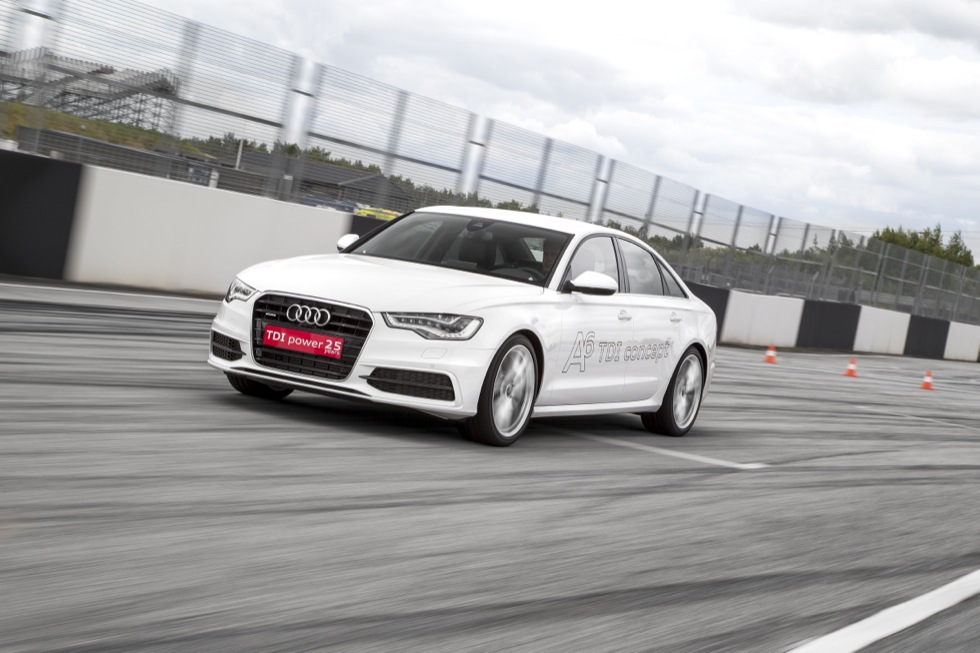| The Audi RS6 pace car next to me revved its engine; it was a mighty speedy machine – but my task was to beat it off the line. My car was an automatic, so we wouldn’t be relying on super-fast gear shifting. Remembering 0-60mph tests for Autocar. I put my left foot firmly on the brake and pressed the throttle with my right. “Go!” said my companion, and it was left foot off, right foot to the floor. Wheels squealed, engines roared and I left him in the dust. It was, of course, a cheat. If you want to get more power out of an internal combustion engine, you can do worse than to create bigger explosions to send the pistons racing up and down. A turbocharger compresses the air flowing into the engine, so you can cram more of it in the chamber allowing more fuel to burn and make that bigger bang. Conventional turbos use the exhaust flowing out of the engine to spin a turbine, which in turn spins an air pump. Trouble is, you have to wait for some exhaust gas to be created, hence the dreaded ‘turbo lag’ before the boost of power. The Audi A6 TDI diesel concept car I was driving on the Sturup test track near Malmo in Sweden had an electric compressor serving its turbocharger. That meant the compressed air was available immediately – and that’s the only reason why I was able to beat a professional driver off the line. A seriously clever bit is that the electricity for the compressor is largely recuperated from the car when it’s coasting. So it doesn’t take power from elsewhere, or increase fuel consumption. It gets its power via a separate 48-volt electrical system (most cars have 12-volt) and has its own lithium-ion battery in the boot. Double the fun We journalists had a lot of fun on the track with two cars: the Audi A6 TDI concept with a 3.0 V6 ‘monoturbo’ producing 326 PS, and the RS 5 TDI concept with a 3.0 TDI biturbo, producing 385 PS, which can accelerate from 0-60mph in about four seconds. Both cars were obviously fantastic off the line and great fun around the track – the biturbo was a real thug. The most important point about both cars, however, is that they demonstrate an alternative to the idea of going from petrol or diesel straight to hybrid or full electric. Instead, electric functions could be added to the car to add performance, or reduce the engine size to allow for lower fuel consumption and emissions. It’s another way of improving the internal combustion engine, rather than ditching it for something completely new. As one of Audi’s engineers pointed out, we’ve been working on this engine for more than 100 years, and there’s so much more it can do, why go back to the drawing board? |
- Welcome
- Woman Driver Blog
-
Top stories
- Mario Andretti interview
- WOMAC 2017
- Getting connected in Melbourne
- Fitting a baby seat
- Haggling Academy
- Men vs Women - the stats
- First Mustang owner was a gal
- Emma Peel vs Alice Morgan >
- Western Group Driving Day
- Transport for four babies
- Women lose advantage
- Sam flies high
- Jo Price beats the boys
- They bought any car Dot Com
- Fast women
- E-types on film
- In which I bought a car
-
Car Reviews
- Mercedes B-Class
- VW Golf SV GT 2014
- Renault Twingo 2014
- Audi A3 Cabriolet
- Jaguar F-type
- Fiat 500 Goes Large
- Putting Paceman through its paces
- Mazda6 and Concorde
- Jaguar Land Rover Experience Day
- VW up! - city car in the country
- Joining the MX-5 Club
- VW Driving Day
- Face-lifted MX-5
- Review: VW Golf 2013
- SMMT Test Day 2012
- Portfolio
-
Galleries
- My cars >
- All-New Discovery at Gaydon
- Silverstone Classic 2016 >
- Hot rods at Pendine 2016
- Hot rod heaven 2013
- Classic Motor Show 2014
- Goodwood Revival 2014
- Beaulieu autojumble 2014
- My favourite hotels
- Bonhams Auction Goodwood 2014
- Women in motoring history
- Riding with BTCC Champ
- Pink c'est chic!
- Bond girls' cars
- Women in Car Advertising
- The woman driver onscreen
- Disney without kids
- Sweeney!
- Geneva Show 2013 Gallery
- Goodwood Revival 2012
- Contact
- Jaguar I-PACE launch




 RSS Feed
RSS Feed
